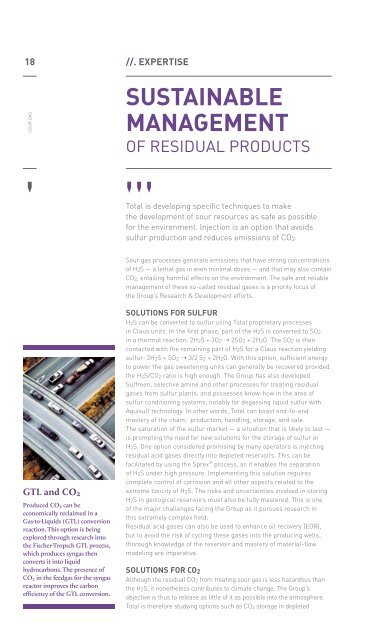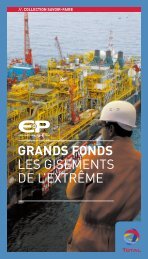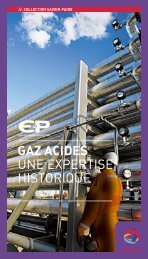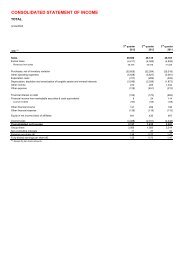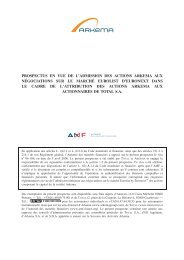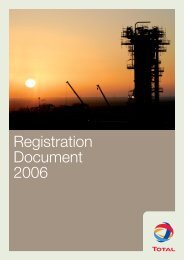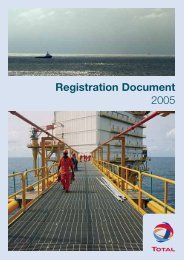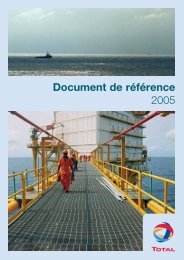Sour gas - A history of expertise - Total.com
Sour gas - A history of expertise - Total.com
Sour gas - A history of expertise - Total.com
Create successful ePaper yourself
Turn your PDF publications into a flip-book with our unique Google optimized e-Paper software.
18<br />
SOUR GAS<br />
s<br />
GTL and CO2<br />
Produced CO2 can be<br />
economically reclaimed in a<br />
Gas-to-Liquids (GTL) conversion<br />
reaction. This option is being<br />
explored through research into<br />
the Fischer-Tropsch GTL process,<br />
which produces syn<strong>gas</strong> then<br />
converts it into liquid<br />
hydrocarbons. The presence <strong>of</strong><br />
CO2 in the feed<strong>gas</strong> for the syn<strong>gas</strong><br />
reactor improves the carbon<br />
efficiency <strong>of</strong> the GTL conversion.<br />
//. <strong>expertise</strong><br />
sUstAinAble<br />
mAnAGement<br />
<strong>of</strong> rEsiduAl products<br />
s s s<br />
<strong>Total</strong> is developing specific techniques to make<br />
the development <strong>of</strong> sour resources as safe as possible<br />
for the environment. Injection is an option that avoids<br />
sulfur production and reduces emissions <strong>of</strong> CO2.<br />
<strong>Sour</strong> <strong>gas</strong> processes generate emissions that have strong concentrations<br />
<strong>of</strong> H2S — a lethal <strong>gas</strong> in even minimal doses — and that may also contain<br />
CO2, entailing harmful effects on the environment. The safe and reliable<br />
management <strong>of</strong> these so-called residual <strong>gas</strong>es is a priority focus <strong>of</strong><br />
the Group’s Research & Development efforts.<br />
solUtions for sUlfUr<br />
H2S can be converted to sulfur using <strong>Total</strong> proprietary processes<br />
in Claus units. In the first phase, part <strong>of</strong> the H2S is converted to SO2<br />
in a thermal reaction: 2H2S + 3O2 ➝ 2SO2 + 2H2O. The SO2 is then<br />
contacted with the remaining part <strong>of</strong> H2S for a Claus reaction yielding<br />
sulfur: 2H2S + SO2 ➝ 3/2 S2 + 2H2O. With this option, sufficient energy<br />
to power the <strong>gas</strong> sweetening units can generally be recovered provided<br />
the H2S/CO2 ratio is high enough. The Group has also developed<br />
Sulfreen, selective amine and other processes for treating residual<br />
<strong>gas</strong>es from sulfur plants, and possesses know-how in the area <strong>of</strong><br />
sulfur conditioning systems, notably for de<strong>gas</strong>sing liquid sulfur with<br />
Aquisulf technology. In other words, <strong>Total</strong> can boast end-to-end<br />
mastery <strong>of</strong> the chain: production, handling, storage, and sale.<br />
The saturation <strong>of</strong> the sulfur market — a situation that is likely to last —<br />
is prompting the need for new solutions for the storage <strong>of</strong> sulfur or<br />
H2S. One option considered promising by many operators is injecting<br />
residual acid <strong>gas</strong>es directly into depleted reservoirs. This can be<br />
facilitated by using the Sprex ® process, as it enables the separation<br />
<strong>of</strong> H2S under high pressure. Implementing this solution requires<br />
<strong>com</strong>plete control <strong>of</strong> corrosion and all other aspects related to the<br />
extreme toxicity <strong>of</strong> H2S. The risks and uncertainties involved in storing<br />
H2S in geological reservoirs must also be fully mastered. This is one<br />
<strong>of</strong> the major challenges facing the Group as it pursues research in<br />
this extremely <strong>com</strong>plex field.<br />
Residual acid <strong>gas</strong>es can also be used to enhance oil recovery (EOR),<br />
but to avoid the risk <strong>of</strong> cycling these <strong>gas</strong>es into the producing wells,<br />
thorough knowledge <strong>of</strong> the reservoir and mastery <strong>of</strong> material-flow<br />
modeling are imperative.<br />
solUtions for Co2<br />
Although the residual CO2 from treating sour <strong>gas</strong> is less hazardous than<br />
the H2S, it nonetheless contributes to climate change. The Group’s<br />
objective is thus to release as little <strong>of</strong> it as possible into the atmosphere.<br />
<strong>Total</strong> is therefore studying options such as CO2 storage in depleted


